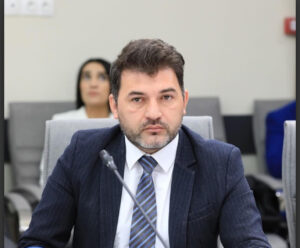Latest Developments in Kazakhstan’s Navy Strengthening
Since independence, Kazakhstan has always demonstrated its interest and readiness to improve its Armed Forces. Since boosting the Caspian security through the successful development of the maritime border capabilities became the vital element of Kazakhstan’s military reform agenda, it was decided to pay special attention to establish the Naval Forces. Actually, the history of the Naval Forces of Kazakhstan dates back to April 2, 1993, when the President Nursultan Nazarbayev signed the presidential decree on the establishment of the Navy. (KazInform, 2012) Therefore, Kazakhstan’s Navy will celebrate its 24th anniversary in 2017. However, it should be noted that the Kazakhstani Navy actually has two dates of birth. The second one took place on May 7, 2003, by signing the presidential decree on further improvement of the structure of the Armed Forces of Kazakhstan. The enforcement of the President’s Decree allowed re-establishing the Navy’s units, which were integrated into the Border Service of the National Security Committee in 1996.[1] Therefore, the Navy is the youngest force of the Armed Forces of Kazakhstan.
The restoration of the Naval Forces was necessitated by both the revitalization of Russia’s Caspian Flotilla[2] and the development of exploration activity of Kazakhstan in the Kazakhstani sector of Caspian Sea. Therefore, it could be assumed that among other purposes such as suppressing all forms of piracy, terrorism, smuggling, and drug trafficking, Kazakhstan’s Naval Forces was formed for the protection of strategically important objects of energy infrastructure in the Caspian Sea, including port zones, oil rigs and artificial islands with oil production facilities on them. (Global Security, 2012) According to the Commander-in-Chief of Naval Forces of the Armed Forces of Kazakhstan, Zhandarbek Zhanzakov, the Kazakhstani naval ships could patrol the open waters of the Caspian Sea up to 150 km from the coast, which is 6-fold larger distance compared to a patrol distance of the ships of the coast guard, which carries out patrols as far as 25 kilometers from the coast. (Kucera, 2010) In order to meet aforementioned goals, it was decided to complete the Navy with a small patrol vessels with a displacement of about 250-300 tons, which could easily operate in the shallow waters of the Northern Caspian Sea.[3] Moreover, after few unsuccessful deals on the marine vessels purchase, Astana decided to launch its own shipbuilding program. For instance, in 2005 the Commander-in-Chief of Naval Forces declared that Kazakhstan would construct its first missile and artillery ship using shipyard facilities of the Zenit naval industrial complex in Uralsk inherited from the Soviet Union. It took 7 more years for Kazakhstan to construct its first missile and artillery vessel.[4] The first Kazakhstani-made missile and artillery Bars-class patrol vessel (Project 0250)[5] named Kazakhstan was constructed in 2012. The same class vessels named Oral and Saryarka were produced in 2013 and 2014 respectively. Moreover, in 2016 the Zenit shipyard launched a new type of small patrol boat for the Kazakhstani Navy’s Special Forces aimed to guard strategic facilities in the port of Aktau against the risk of underwater sabotage.[6] (Mazumdar, 2016) Therefore, Kazakhstan is sustainably implementing its strategy to form small tonnage vessels Navy.
Moreover, Kazakhstan’s Naval Forces has a big progress in terms of improving its technical equipments, personnel training and staffing. Actually, in 2016 the Naval Forces of Kazakhstan showed its best operational results. For instance, in 2016 the Kazakhstani Navy finally launched the first raid minesweeper named Alatau constructed by Russia’s Sredne-Nevsky Shipyard. Moreover, within the framework of the expansion of Aktau seaport to the north, Kazakhstan completed the construction of the offshore naval pier eliminating the need for docking the military vessels at a chartered pier in the Bautino port located 140 km from the Naval Base in Aktau. It is clear that building the naval pier is considered as eagerly anticipated event for the Navy’s officers. With this naval pier, the Kazakhstani Naval Forces could increase its efficiency and ensure timely action relating to security in the Caspian Sea. Furthermore, in October 2016 Kazakhstan’s Special Naval Forces for the first time receive a mobile diving system[7] produced by the Uralsk-based Gidropribor Research Institute and designed for protection of underwater of the Caspian Sea.
According to the report of the Ministry of Defense of Kazakhstan, in 2016 Naval Forces held over 3600 naval exercises compared to 2600 military drills conducted in 2015. According to the published data, the Naval Forces of Kazakhstan conducted tactical-military exercises, command and staff trainings, with the involvement of the military units of the Aktau garrison and other branches of the Armed Forces. Moreover, during the reporting period, the Kazakhstani warships passed over 30,000 nautical miles, which is 48.3% increase in comparison with 2015. (Minisrty of Defence, 2017) The Kazakhstani Navy vessels also increased the total time of staying at the sea. For instance, in the first years the Kazakhstani military ships stayed at the sea only for 10-20 days a year, in the period of 2013-2015 the amount of days spent at the sea totaled 150-160 days per year (Minisrty of Defence, 2017), while in 2016 the naval vessels of Kazakhstan spent 240 days or almost 5,800 hours at the sea.
It should be also admitted that the Naval Forces could manage to increase the training level of its staff. Nowadays, Kazakhstan is teaming up with its partners to further improve its Caspian Naval Forces. Currently, training is carried out primarily on the basis of international treaties, namely, in the naval educational institutions of Russia, Turkey, Germany, China, South Korea, Pakistan and the United States. (KazInform, 2012) Moreover, Kazakhstan carried out the education of the Navy’s servicemen at two universities in the cities of Aktau and Uralsk and the Aktau Naval Training Center.
Therefore, it could be concluded that Kazakhstan is on the way to develop its Navy by both creating the coastal navies infrastructure, further improvement of training programs and increasing the number of the military vessels within the Naval Forces. Moreover, there is a long-term plan to launch the production of the specialized multipurpose support vessels with displacement of 600 tons that could carry floating laboratories, search and rescue and fire vessels, etc. There is no doubt that Kazakhstan will continue building its naval capabilities. However, there should be clear understanding that Kazakhstan was not forced to intensify its navy-building activity. Actually, Astana does not consider any of littoral states as potential threat to national security. Moreover, Kazakhstan has no claims over the disputed offshore fields in the Caspian Sea and has already settled the subsoil delimitation issue with Russia, Azerbaijan and Turkmenistan.
References
Global Security. (2012). Kazakhstan Navy.
Retrieved from http://www.globalsecurity.org/military/world/centralasia/kazak-navy.htm
KazInform. (2012). Kazakhstan laid basis of well equipped sea forces by strengthening its defense potential – Commander-in-Chief of Naval Forces of the Armed Forces of Kazakhstan Z. Zhanzakov.
Retrieved from http://www.inform.kz/en/kazakhstan-laid-basis-of-well-equipped-sea-force…
Kucera, J. (2010). Kazakhstan Gets Jump on Caspian Naval Race.
Retrieved from http://www.eurasianet.org/node/61386
Mazumdar, M. (2016). Kazakhstan Launches New Special Forces Small Craft, Progresses Corvette Programme.
Retrieved from http://www.janes.com/article/62483/kazakhstan-launches-new-special-force…
Minisrty of Defence. (2017). Poryadka 3 600 korabelnykh uchenii otrabotali VMS Kazakstana.
Retrieved from https://www.mod.gov.kz/rus/struktura/vooruzhennye_sily_rk/voenno-morskie…
Minisrty of Defence. (2017). Segodnya 23 goda so dnya obrazovaniya VMS RK .
Retrieved from https://www.mod.gov.kz/rus/struktura/vooruzhennye_sily_rk/voenno-morskie…
[1] In late 1993, Kazakhstan received about 25% of the patrol boats of the USSR’s Caspian Flotilla, which subsequently constituted the entire Naval Forces of the country. It was initially planned that Fort Shevchenko would become the Kazakhstani naval base on the Caspian Sea, however, a scarcity of funds delayed implementation of the project. Moreover, as in the mid-1990s, Kazakhstan had a minimal requirement for the Naval Forces it was decided that the Navy should be included in the Caspian Border Service.
[2] In August 2002, Russia conducted the largest joint maneuvers of its Caspian flotilla in post-Soviet history, namely, the Sea of Peace-2002 anti- terrorist military exercises.
[3] It was planned that for the deep southern parts of the Caspian Sea, the Kazakhstani Navy should use ships with a displacement of 500 tons that will be purchased from other countries. However, to date, the Kazakhstani authorities do not prefer to implement the mentioned plans.
[4] The Zenit shipyard also launched the production of vessels for the coast guard service of Kazakhstan. To date, the shipyard commissioned 4 boats of the Sunkar-M-class (Project 100M); 7 boats of the Burkit-M-class (Project 0200M); 5 ships of the Bars-class (Project 0300); 2 high-speed patrol boat of the Aybar-class (Project 0210). Moreover, 4 high-speed patrol boats of the FC19 project are under construction.
[5] The vessel with a displacement of 240 tons can reach speeds of 30 knots. The length of the vessel is 46 m and it is 9 meters in width. It is equipped with ultramodern navigation systems, onboard desalination plant, thanks to which the ship can be at sea for 10 days. The vessel is equipped with modernized anti-aircraft missile and artillery units.
[6] The 12-ton ship is 13 m long, 3.5 m in beam, and has a draught of 0.6 m.
[7] The complex is located on the basis of KAMAZ off-road type.
*************************************************************
Lidiya Parkhomchik
http://eurasian-research.org/en/research/comments/security/latest-developments-kazakhstan%E2%80%99s-navy-strengthening
Share this content:









Yorum gönder